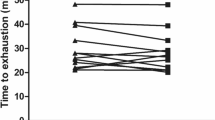Abstract
A technical description, constructional details and performance characteristics are presented for a whole-body calorimeter. With the equipment metabolic heat production (oxygen consumption), sensible (radiative and convective) and insensible heat exchange (water vapour loss) of a subject during rest and exercise can be monitored continuously. The basic principle of the construction is to prevent any heat transfer across the wall of a well ventilated cylinder, so that all heat exchange by the subject can be measured by differential thermometry and hygrometry between inlet air and outlet air. The air flow through the calorimeter itself is more than 12·5 m3 min−1, which makes its response to changes in heat dissipation of the subject fast. The time constant for evaporative water loss is 1·5 min. There are two time constants for sensible heat exchange: 0·86 min and 7·4 min. The calorimeter inlet air temperature is controlled to within 0·03°C and dewpoint temperature to within 0·15°C. Changes in sensible heat exchange can be measured with an accuracy of 1 W. Changes in water vapour loss can be detected within 100 mg min−1; consequently, changes in insensible heat exchange can be assessed to about 4W. There is no heat loss through the wall of the calorimeter, even at a temperature difference between calorimeter temperature and laboratory temperature close to 30°C, and the calibrations are correct. This has been verified by measuring water vapour losses from a water tray at various calorimeter temperatures and the heat required for this evaporation. The latter can be measured as sensible heat exchange. The quotient of the two gives the heat of vaporisation of water, which can be compared favourably with the values from steam tables. Particular emphasis has been given to the subject's safety and comfort.
Similar content being viewed by others
References
Auguet, A. andLefèvre, J. (1929) Nouvelle chambre calorimetrique du Laboratoire de Bioenergetique.Compt. Rend. Séanc. Soc. Biol.,C, 251–253.
Kelly, C. F., Bond, T. E. andHeitman, H. (1963) Direct “air” calorimetry for livestock.Transact. Am. Soc. Agr. Eng., 126–128.
Snellen, J. W. (1966) Mean body temperature and the control of thermal sweating.Acta Physiol. Pharmacol. Neerl.,14, 99–174.
Snellen, J. W. andBaskind, P. (1969) The air-conditioning system, and operation and performance of the human calorimeter of the Human Sciences Laboratory. C.O.M. Report No. 24/69, Chamber of Mines of South-Africa.
Snellen, J. W. andChang, K. S. (1981) A calorimeter ergometer for concentric and eccentric work.Med. & Biol. Eng. & Comput.,19, 356–358.
Visser, J. andHodgson, T. (1960) The design of a human calorimeter for the determination of body heat storage.The South African Mechanical Engineer,9, 243–260.
Weir, J. B. de V. (1949) New methods for calculating metabolic rate with special reference to protein metabolism.J. Physiol. (London),109, 1–9.
Author information
Authors and Affiliations
Rights and permissions
About this article
Cite this article
Snellen, J.W., Chang, K.S. & Smith, W. Technical description and performance characteristics of a human whole-body calorimeter. Med. Biol. Eng. Comput. 21, 9–20 (1983). https://doi.org/10.1007/BF02446401
Received:
Accepted:
Issue Date:
DOI: https://doi.org/10.1007/BF02446401




